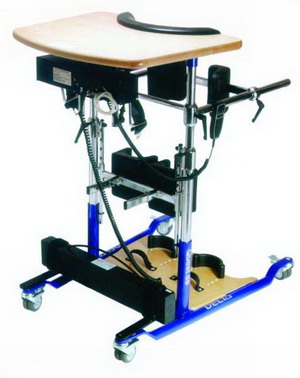Standing-Frames
Standing frames are a very important tool in any rehabilitation plan. Here we will discuss how they are used.
Because disabilities vary, there are many types of standing frames available. For example, people who need to stand up in one position use a passive standing frame, also known as a static stander. A passive standing frame may have casters but the person would need assistance in moving the frame from place to place.
The disabled person can move a mobile standing frame by himself or herself to get from place to place. One version of a mobile (or dynamic) standing frame is an active standing frame, which allows the user to move the arms and legs, similar to a regular walking gait.
Standing frames are used in many different situations, such as by stroke patients or by those with spinal cord injuries. Standers have many benefits; for example, people who are bed-bound are prone to pressure sores that occur when pillows and mattresses press against parts of the body for a long time. Patients who use a stander can avoid these painful sores that are prone to infection.
In addition, disabled people who use a stander can improve their balance and the strength of many parts of their bodies. Many body systems benefit from standing, including the circulatory system, the digestive system and the respiratory system. Standing also improves bone density and prevents muscle contractions and spasms.
Using a standing frame not only improves the body physically, it has also been proven to help the disabled person mentally and emotionally. Research has shown that the use of standing frames improves self esteem and mental outlook.
The choice of a standing frame is very important. It must be sized correctly and function correctly for the specific person. Children may need to get new standers periodically as they grow. A standing frame also should be easily adjustable for the user and his or her aides but stable enough that the person feels secure.
In addition, the standing frame must be properly sized to fit the area in which it will be used. It must fit through doorways and may have to meet weight restrictions.
Costs for standing frames vary according to what accessories are supplied. Some are electrically powered while others are manually operated. Standers are available with table stands and supports for ankles, heels, knees, the back, and hands and are generally quite expensive.
As with any rehabilitation tool, it takes time to use a standing frame. At first, the person may only be able to stand for a moment but as they become stronger, it will be possible to stand for longer periods of time.
There is a variety of standing frame manufacturers, many of whom provide free delivery and set-up. A therapist will be able to recommend which are the best for the patient's needs. If used correctly, a standing frame provides many benefits for a person with disabilities. It is worth the expense to buy and use one.

